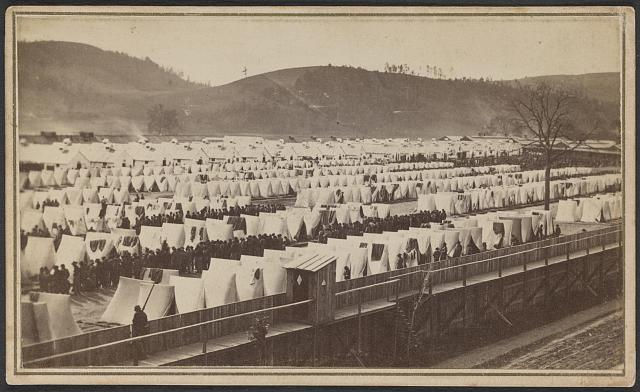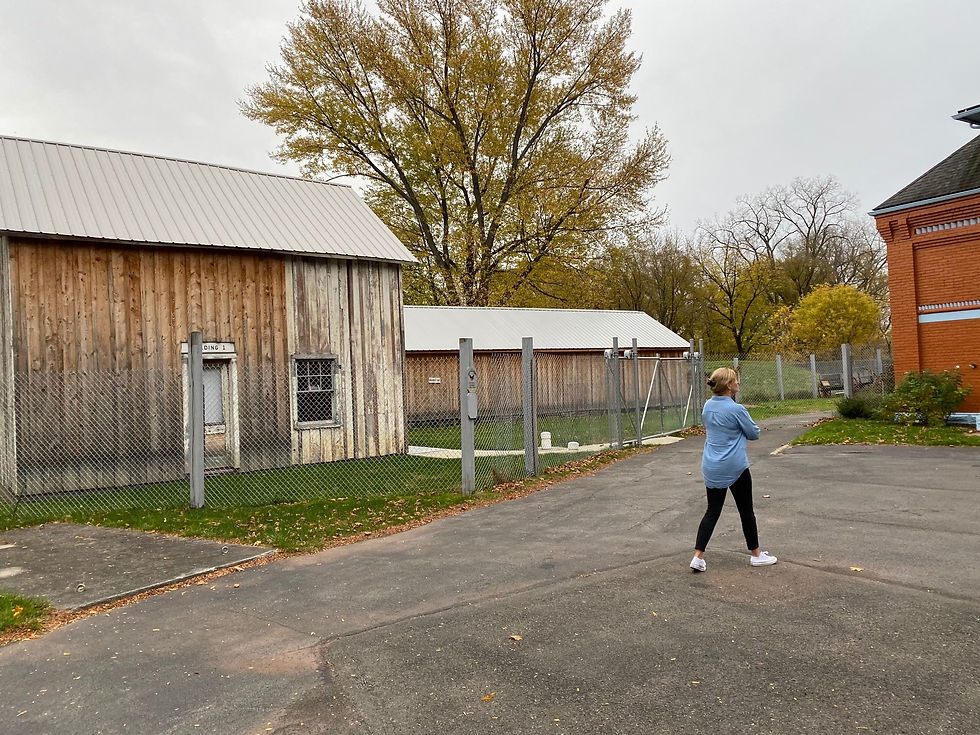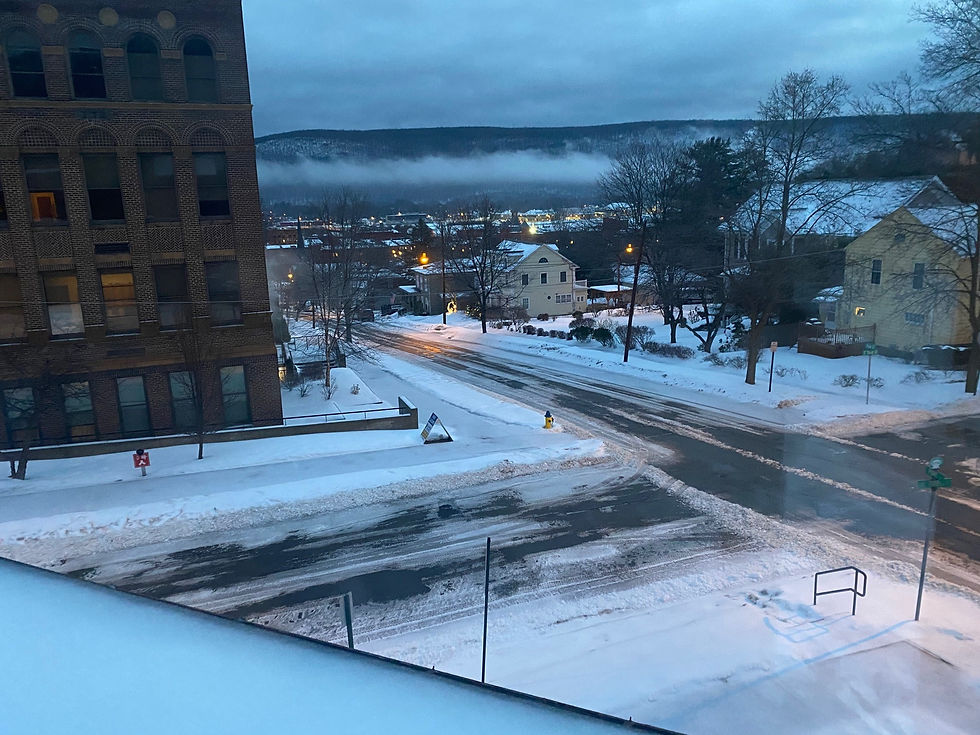
Once you've been here a while, you realize there are two very different communities sitting next to one another along the valley of the Chemung River. Here we are in Corning, with a long history of industriousness, education, and prosperity that makes it an idyllic place to sit out a pandemic.
Next door to the east is Elmira, a little bigger, grittier, and with a demographic more apt to be poor, overweight, and bearing a whole host of morbidities that make Peg's job tougher when they show up in the operating room. In other words, they're more like the folks who comprise our communities back home in rural Florida.
It may not be happenstance that they bear so much resemblance to Southerners. During the Civil War, this place was home to 12,000 unfortunate Confederate prisoners of war who got to spend the desperately cold winter of 1864-65 stockaded in a space maybe 500 yards by 600 yards, malnourished and freezing. A quarter of them died.
Elmira Prison was the result of a deliberate policy choice in the north. Until 1863, prisoners were usually paroled and returned across enemy lines after signing a rarely kept promise not to return to armed service. That all ended when Lincoln realized that prisoner exchanges were far more beneficial to the undermanned Confederacy than the Union, and that once black soldiers began filling the Union ranks the armies of the South had a bad habit of either murdering them upon capture or returning them to slavery, even if they had been born free. Hence, no more paroles.
Thus both sides suddenly found themselves with swelling ranks of prisoners, a condition made more acute by the brutal campaigns in Virginia and Georgia in the summer of 1864. The South had its Andersonville, and its Libby Prison. The North had the horrible Camp Douglas, near Chicago, and this place, the former Yankee Camp Rathbun.
One can't help wonder if there was a measure of malice rather than mere neglect in what happened here. Scurvy was an ongoing problem, and the prisoners were kept on the brink of starvation in a place that was a breadbasket of the Union. As one might expect based on the nature of their calling, the medical professionals assigned to take care of the men constantly complained up the chain of command that folks were unnecessarily sick and dying, to no avail.
One fact that seems to arise in many stories of Civil War POW camps was the existence of a small body of water the prisoners used both as a water source and a latrine. Elmira had its own fetid pond. It seems incredible that they did not appear to realize this was a death sentence for many, although perhaps they felt they had little choice but to live this way.
In the first months of the camp, when the weather was fine in the fall of 1864, the locals built a tower so they could peer over the wall at the spectacle of thousands of these walking scarecrows who had survived the horrors of the Wilderness and Cold Harbor, only to find themselves here. The prisoners put on impromptu acrobatic shows, and the mood was fairly light until it got cold. Really cold.
By February of 1865, this place had seen winter days that were well below zero, and blizzards blanketing the valley in two feet of snow. Prisoners who arrived in summer gray uniforms froze to death, and disease ran rampant as they crowded together to stave off the cold.
The last prisoners left here in the summer of 1865. Three thousand who weren't so lucky are buried in a well-maintained cemetery nearby. I've heard a number of the survivors never went home, stayed here and raised families whose descendants are probably kin to those obese diabetics Peg now puts to sleep.
There is not much left of the camp. As one might expect, a legacy so awful did not seem like much of a candidate as a tourist attraction or hagiographic monument to Yankee pluck.

But I read somewhere that the local chamber is trying to reassemble something folks would pay to see. Hey, tourists travel to Auschwitz, so why not?
What got me thinking about all this, as I watched the underpowered remnants of a winter storm that buffeted everywhere from Dallas to the Gulf Coast limp through here in the predawn hours? I don't know. Peg and I are Southern sojourners ourselves, but our experience bears no resemblance to what those guys endured just downriver all those years ago.
Maybe it's the notion that the legacies of these events hang like shadows over communities that experienced them. Is Elmira a different place for the fact that its burghers were complicit in what amounted to the institutional torture and murder of several thousand men? I guess it's sort of like a premise I've written about before, the sense of evil that hangs over a place where man's inhumanity to man was the defining act of the community. Jim Thorpe, Pennsylvania comes to mind--you can't change your name from Mauch Chunk and hope everyone forgets the judicially sanctioned murders that happened up there at the top of the hill. Or Goliad, Texas, where Santa Anna's lancers ran through several hundred Texan POWs who were promised safe passage in exchange for their surrender. The demons still walking that field touch one viscerally, like a sudden chill. Or Andersonville, Georgia, where the Confederacy took inhumanity to its prisoners to a new level, and thousands succumbed to disease, starvation, and serial execution.
I say all that, but Elmira isn't Andersonville. It is actually a pretty town, for the most part. It has a nice live theater, a college, a district of stately Victorian homes available for far less than what you'd pay up here on Southside Hill in Corning. Hell, Mark Twain spent his summers in Elmira.
But the legacy remains, reflected in the social and economic chasm between these two little towns. One place built its livelihood around enterprise, innovation, and creating beautiful, functional things that make Corning a household name around the planet. One made its living guarding prisoners, and does so to this very day at the state prison there. A lesson lies here for all the chamber of commerce types back home who can't wait to get a prison or two in their neighborhood, while maintaining a substandard school system and infrastructure that is laughably inadequate for a modern economy. Who do you want to be, exactly?
There I go down a rabbit hole again.
A tropical 33 degrees here in Corning, so we won't be getting the ten inches of snow they were promising only a few hours ago. Everything is coated with ice from the freezing rain that arrived instead--I was out in the darkness at 6 am tossing buckets of salt onto our front steps, where the ice was nearly an inch thick.
It is Mardi Gras, but no one here observes that tradition. Well, no one except those of us here at Wyldswood North, where there will be zydeco, Peg's homemade gumbo, and lots of laughter along with a little wine and Abita beer. It is part of who we are, we two strangers in a strange land.

Comments